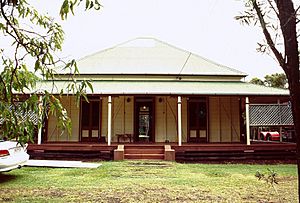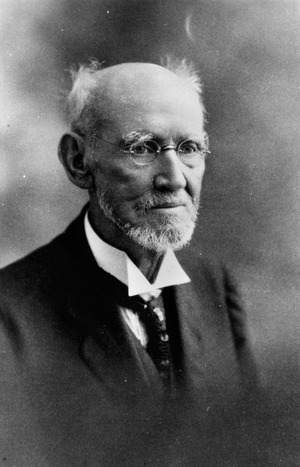Canambie Homestead facts for kids
Quick facts for kids Canambie Homestead |
|
|---|---|

Canambie Homestead, 2000
|
|
| Location | 12 Dixon Road, Buderim, Sunshine Coast Region, Queensland, Australia |
| Design period | 1870s - 1890s (late 19th century) |
| Built | c. 1883 |
| Official name: Canambie Homestead, Joseph Dixon's House | |
| Type | state heritage (built) |
| Designated | 22 October 2000 |
| Reference no. | 602166 |
| Significant period | 1880s (fabric) 1880s-1970s (historical) |
| Significant components | farmhouse, plantings - exotic |
| Lua error in Module:Location_map at line 420: attempt to index field 'wikibase' (a nil value). | |
Canambie Homestead is a special old house located in Buderim, Queensland, Australia. It was built around 1883. This homestead is also known as Joseph Dixon's House. It's considered a very important historical site. Because of its history, it was added to the Queensland Heritage Register in 2000. The name "Canambie" is believed to be an Indigenous word meaning "black plum."
Contents
The Story of Canambie Homestead
Canambie Homestead was likely built in the early 1880s. It was for Joseph Chapman Dixon, his wife Elizabeth, and their family. Joseph Dixon was a sugar planter and owned a sugar mill on Buderim Mountain. The house is still a home today. It is one of the oldest wooden houses still standing on the Buderim plateau.
Joseph Dixon's Journey
Joseph Dixon came to Australia from England in 1864. He was in his early twenties. After working in Sydney for a few years, he heard about the successful sugar industry in Queensland. In 1868, he visited the Moreton Bay area. He was guided by a timber cutter named William Grigor.
In 1869, Joseph returned to Queensland with friends. They chose land near the Mooloolah River to grow sugar cane. But floods damaged their crops. So, they moved to another sugar plantation near Brisbane. While at Mooloolah, Joseph learned about Buderim Mountain. In 1870, he became the first person to claim land there.
Early Days on Buderim Mountain
Before Joseph arrived, Buderim Mountain was known for its valuable timber. People cut down trees like red cedar and white beech. They shipped the timber to Brisbane. In 1870, the land was opened for farming. Joseph Dixon claimed two large pieces of land. He built his first home, a simple slab hut, on one of them.
Early farmers often earned money from timber. They cleared the land for farming. Joseph also raised cattle and sold meat to his neighbours. He even hired someone to haul timber to the coast. In 1871, only three houses were on Buderim Mountain. But more people soon moved there. A postal office opened in 1874.
Family Life and Sugar Mills
In 1873, Joseph Dixon married Elizabeth Alice Fielding. She was from Eagle Farm, near Brisbane. They moved back to his slab hut on Buderim Mountain. By 1874, Joseph was growing maize and sugar cane. Sugar cane became a very popular crop on the mountain. Many sugar planters used workers from the Pacific Islands to help.
In 1875, Joseph and his father-in-law, John Fielding, started the first sugar mill on Buderim Mountain. They bought a sugar plant from Scotland. It was brought up the mountain by bullock wagon. The first sugar cane was crushed in October 1876. Later, they updated their mill to make it more efficient.
Growing Influence and Community Role
By 1881, Joseph Dixon owned a lot of land on Buderim Mountain. He was one of the biggest landowners. He also owned land with John Fielding, including the mill site. By the mid-1880s, he owned even more land.
It's not exactly clear when Canambie Homestead was built. Records from 1881 show Joseph had several slab houses. But by 1884, his land had a sawn-timber house and stables. This likely refers to Canambie Homestead.
Joseph Dixon was very active in the Buderim community.
- He helped start a school in 1875-76.
- He was the secretary of the School Committee for many years.
- He became a Justice of the Peace in 1876.
- He took over the postal office in 1876.
- When it became a full post office in 1884, he was the first postmaster.
- He also helped establish the Buderim School of Arts.
- In 1895, he even opened a school for his Pacific Islander employees.
Changes in the Sugar Industry
In 1880, a second sugar mill opened on the mountain. Buderim farmers made good money from sugar at first. Many slab homes were replaced with nicer wooden houses. A small village grew around the main roads.
However, laws changed in 1885. These laws made it harder to employ Pacific Islanders on sugar farms. This forced most Buderim Mountain farmers to grow other crops. They started growing bananas and oranges instead. By 1889, the second sugar mill had closed. Joseph Dixon was the only farmer still growing sugar cane on a large scale.
Joseph Dixon closed his mill in 1896. He felt it was no longer profitable. He also faced competition from a new, larger sugar mill in Nambour. He sold his mill equipment but kept his land in Buderim.
After the Dixons
Joseph Dixon later moved to Gympie and worked in the boot business. He then returned to Flaxton and started a successful dairy farm and citrus orchard. Joseph and Elizabeth Dixon lived in Flaxton until they passed away in the late 1920s. Roads in Buderim, like Dixon Road and Mill Road, are named after the family.
After the Dixons left, John North Burnett may have lived at Canambie. He was a fruit grower. In 1905, Joseph Dixon sold the homestead property to John North Burnett. The property changed hands several times. The Hamilton family owned it from 1938 until the late 1960s or 1970s. New owners in the 1970s did a lot of work to restore the house. A separate building was also added in the backyard around the 1970s. It was built to match the style of the main house.
What Canambie Homestead Looks Like
Canambie Homestead sits on a large block of land in central Buderim. It is on a high ridge, facing southeast.
It's a large, single-story timber house. The wood used was local beech, red cedar, and other hardwoods. The house sits on low stumps. It has a short roof covered with corrugated iron. Verandahs surround the main part of the house. These verandahs have simple wooden posts and decorative wooden brackets. French doors open from each room onto the verandahs. Part of the back verandah has been closed in. It is now used as the kitchen.
Inside, the house has a long, wide central hallway. On the left, there's a front living room and a dining room. On the right, there are three bedrooms. Above each inside door, there's a fancy wooden panel for air circulation. Three folding cedar doors can open between the living and dining rooms. This creates one big space for parties. The dining room has a fireplace with a beautiful cedar frame. There's also a built-in dresser next to the fireplace.
The ceilings are painted white. The walls are oiled wood, which gives them a rich, warm look. All the wooden doors and frames are made of shiny red cedar. The floors have been recently polished.
In the backyard, there's a separate building from the 1970s. It's also made of timber and sits on a concrete slab. It looks similar to the main house. It has verandahs on three sides with matching wooden posts and brackets. It also has French doors. Inside, it's one large room.
The house is set back from the street. It has a tall timber fence from the late 20th century. The trees in the front yard seem to be from the same time. On the side of the house, there's a wooden trellis with a very old grape vine. This vine is likely from the early days of the homestead.
Why Canambie Homestead is Important
Canambie Homestead was added to the Queensland Heritage Register in 2000. This means it's recognized as a very important historical place. Here's why:
- Shows Queensland's History: The homestead helps us understand how Buderim Mountain first developed. It shows the early success of growing sugar and having sugar mills in the area.
- A Rare and Special Place: It's one of the oldest homes still standing on the Buderim plateau. It's still mostly in its original condition. It shows what a large, well-built farmhouse from the early 1880s looked like. It was built with local timbers that are hard to find today.
- Beautiful Design: The materials, the detailed woodwork, and the simple design of the house are very beautiful.
- Important to the Community: This house is one of the best early homes on the mountain. It has a special connection to the history of the Buderim community.
- Connected to Important People: Canambie Homestead is important because of its strong link to the Joseph Dixon family. They were among the first settlers on Buderim Mountain. Joseph Dixon, with John Fielding, started the first sugar mill there in 1876.


